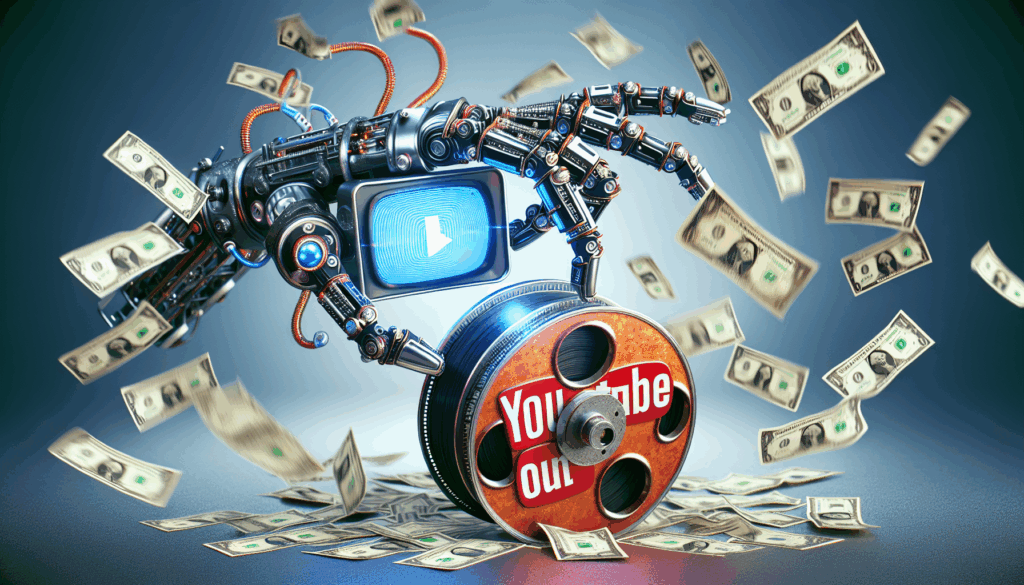Below is an in-depth, chapter-by-chapter guide on harnessing the power of AI to build, grow, and monetize a YouTube channel. Each chapter expands on actionable insights, detailed examples, and research-backed recommendations to help you take your content creation to the next level.
─────────────────────────────
Chapter 1: Introduction to AI-Powered YouTube Channels
In today’s fast-paced digital world, AI-powered YouTube channels are transforming the way content is created and distributed. The integration of artificial intelligence into content production isn’t just a futuristic fantasy—it’s a reality that’s now streamlining workflows, reducing costs, and fostering creativity. With AI, creators can automate mundane tasks like video editing, voiceovers, thumbnail creation, and even content planning. The result is a channel that can be more consistent, engaging, and optimized for growth.
At its core, AI simplifies the video creation process by handling repetitive tasks and offering data-driven insights to help you refine both your content and strategy. For instance, AI tools can help match scripts with the perfect visuals or generate high-quality images for your thumbnails, ensuring your channel stands out in a competitive landscape. Think of it as your behind-the-scenes partner, ready to shoulder the technical workload while you focus on storytelling and engaging your audience.
Recent research and case studies show that channels using AI tools enjoy improved efficiency, allowing creators to post more frequently without sacrificing quality. As a result, your potential to reach a wider audience and generate passive income increases. Embracing this technology is an essential step in future-proofing your online presence, particularly if you’re aiming for a sustainable income model.
For more detailed insights on how AI is reshaping the industry, check out this article on the evolving role of AI in content creation from Toolspedia (https://toolspedia.com/ai/best-ai-tools-for-youtube-creators/?utm_source=openai).
─────────────────────────────
Chapter 2: Success Stories – AI Revenue Pro and Others
Nothing inspires confidence like success stories. One standout example is the channel “AI Revenue Pro,” which has mastered the integration of AI tools to scale its operations quickly. By leveraging AI-driven video creation tools and data analytics, AI Revenue Pro has managed to craft content that is both engaging and algorithm-friendly, achieving rapid growth in subscribers and revenue.
Consider the approach taken by AI Revenue Pro:
• They use tools like Synthesia to generate engaging AI avatars and voiceovers, streamlining production across multiple languages.
• They incorporate AI-based video editing software to transform raw footage into polished, attention-grabbing videos in minutes.
• They blend traditional content creation methods with automated insights to ensure every video is optimized for maximum viewer engagement.
Other channels have adopted similar strategies—using platforms like Pictory to repurpose long-form content into short, digestible videos and MidJourney to create visually stunning thumbnails. These successes underscore the versatility of AI-enabled solutions, providing every creator—from beginners to experienced professionals—a set of tools to maximize efficiency and revenue.
For an in-depth look into some of the best AI tools and how creators are using them, see sources like Learning Revolution (https://www.learningrevolution.net/youtube-tools/?utm_source=openai) and GeeksforGeeks (https://www.geeksforgeeks.org/12-best-ai-tools-for-youtube-creators/?utm_source=openai).
─────────────────────────────
Chapter 3: Setting Up Your AI-Assisted YouTube Channel
Getting started with a new YouTube channel might seem overwhelming, but using AI can simplify many aspects of the setup process. Here’s a step-by-step guide to setting up your AI-assisted channel:
1. Define Your Niche and Audience
Begin by identifying the niche you’re passionate about. Use AI analytics tools to research trending topics and gauge audience interest. Platforms like Google Trends and social media insights can complement AI-driven recommendations to ensure you’re targeting a profitable niche.
2. Establish Your Brand
Your channel’s name, logo, and overall branding should reflect your unique value proposition. AI design tools like Canva and MidJourney can help generate professional-quality visuals swiftly, ensuring your channel has a coherent and attractive aesthetic from the start.
3. Set Up Your Channel
Create your YouTube account and optimize your channel settings, including:
• A compelling channel description.
• Custom thumbnail templates generated using AI tools.
• Organized playlists and categories to enhance user navigation.
4. Plan Your Production Pipeline
Integrate AI tools from the beginning by designing a workflow. For example, plan how you will use Lumen5 to convert blog posts into videos, or Descript to streamline your editing process with AI-assisted voice cloning.
5. Test and Iterate
Start with a pilot video and analyze its performance using YouTube Analytics. AI insights can help you fine-tune everything from video length to call-to-action placements. Experiment with different tools until you find the optimal setup.
By embracing these initial steps, you lay the groundwork for a channel that not only delivers content efficiently but is also primed for rapid growth. For more actionable details on setting up your channel, resources like QuickCreator provide in-depth guidelines on YouTube monetization and compliance (https://quickcreator.io/blog/monetizing-ai-driven-content-on-youtube-guide/?utm_source=openai).
─────────────────────────────
Chapter 4: Content Planning with AI Tools
Content planning is the cornerstone of a successful YouTube channel, and AI can significantly streamline this process. Instead of spending hours brainstorming topics, scripting, and storyboarding, you can harness AI’s analytical capabilities to create a well-structured content calendar.
1. Topic Generation
With AI-powered keyword research tools, quickly identify trending topics and audience interests. Tools like TubeBuddy and VidIQ have features that let you track viewer engagement and pinpoint what’s working in your niche.
2. Scriptwriting and Storyboarding
AI writing assistants can help you create engaging narratives or even fully developed scripts. For example, you might use AI to draft a script outline, which you can refine to match your personal touch. Additionally, platforms like Lumen5 can convert these scripts into storyboard-ready visuals, matching text with relevant images and music.
3. Content Calendar Automation
Use project management tools integrated with AI to schedule and prioritize your video releases. This ensures consistent posting and helps avoid the last-minute scramble that often hampers quality. Tools like Trello with AI plugins can automatically suggest posting times based on past engagement metrics.
4. Performance and Audience Analysis
Leverage YouTube Analytics, boosted by AI insights, to monitor which topics resonate most with your audience. AI can predict trends and provide personalized recommendations on content adjustments to maximize viewer retention and interaction.
In practice, many successful channels repurpose blog posts or articles into videos by simply feeding the content into tools like Pictory, which then distills the article into a series of engaging, short-form videos. This process not only raises productivity but also offers a diversified content format to capture a broader audience slice.
By integrating these AI-driven approaches into your content planning workflow, you significantly reduce the time spent on brainstorming and increase the time available for creative execution. For further reading on these methods, visit Learning Revolution’s insights on YouTube tools (https://www.learningrevolution.net/youtube-tools/?utm_source=openai).
─────────────────────────────
Chapter 5: Video Creation – AI Tools and Techniques
The heart of any great YouTube channel is its video content. With AI tools, video creation becomes faster, less labor-intensive, and often more innovative. Below are some techniques and tools that have proven their worth in the world of AI-powered content creation:
1. AI-Driven Script-to-Video Conversion
Platforms like Lumen5 are revolutionizing the way videos are made by taking written content and automatically pairing it with relevant visuals and background music. This means that even repurposing a pre-existing article can result in a polished video.
2. Transforming Long-Form Content
Pictory excels at compressing long videos or articles into bite-sized, shareable clips. This is particularly useful if you’re looking to repurpose webinars, podcasts, or in-depth tutorials, making the content more accessible to viewers with short attention spans.
3. AI Avatars and Voiceovers
Tools such as Synthesia allow you to generate videos featuring AI avatars, complete with natural-sounding voiceovers. This can be particularly useful for channels that focus on information-heavy content where a traditional presenter might not be necessary. Additionally, Eleven Labs and Descript offer hyper-realistic AI voice clones, making it possible to produce coherent narration without the need for professional recording.
4. Automated Video Editing
The editing process, often the time-consuming phase of video production, can be dramatically sped up with AI-driven software like CapCut or Magisto. These tools not only cut your raw footage into a cohesive story but also add subtitling, transitions, and even background tunes automatically.
5. Enhancing Visual Elements
The visual appeal of your videos is crucial for engaging viewers. MidJourney is an excellent tool for generating high-quality images for your thumbnails and in-video graphics, while StoryBlocks can provide a library of premium stock footage and music to elevate production quality.
As you implement these techniques, remember that the goal isn’t merely to automate but to enhance creativity and maintain authenticity. The human touch still matters—use AI as a tool to free up creative energy for storytelling and strategic decision-making. For detailed reviews and comparisons of these tools, refer to the TopView.ai blog (https://www.topview.ai/blog/detail/The-ONLY-AI-Tools-You-Need-to-Make-Money-on-YouTube?utm_source=openai).
─────────────────────────────
Chapter 6: Monetization Strategies for AI-Driven Channels
Once your AI-powered channel is operational, the next step is turning your content into a sustainable income. Monetizing your channel effectively requires a mix of traditional strategies, adapted for the unique benefits that AI offers, along with creative new approaches.
1. YouTube Partner Program (YPP)
The most common monetization method is joining the YouTube Partner Program. To be eligible, however, you must reach 1,000 subscribers and 4,000 valid public watch hours over the past year. AI can be a major asset here, as data-driven insights from your analytics help optimize video lengths, posting schedules, and content formats to reach these thresholds faster. For details on eligibility and tips to accelerate your growth, refer to QuickCreator’s guide (https://quickcreator.io/blog/monetizing-ai-driven-content-on-youtube-guide/?utm_source=openai).
2. Affiliate Marketing
Integrating affiliate links into your video descriptions or even within your content can generate additional revenue. AI tools can aid by analyzing which affiliate products might resonate best with your audience based on their viewing history and engagement patterns. Always ensure that your affiliate promotions are transparent and relevant, preserving your audience’s trust.
3. Sponsored Content
Once your channel achieves a certain level of influence, brands may approach you for sponsored content. Here, AI’s ability to analyze your demographics and viewership statistics can be a powerful negotiating tool. Ensure that sponsored content aligns with your audience’s interests, and always maintain creative integrity by clearly disclosing partnerships.
4. Diversifying Income Streams
Some creators experiment with crowdfunding platforms, merchandise, or even premium content subscriptions. AI-driven insights can help you understand which of these revenue streams might be most profitable given your niche and audience behavior.
When integrating AI-assisted content into your monetization strategy, it’s important to continuously monitor performance. AI analytics tools can offer real-time data on view metrics, click-through rates, and conversion rates from affiliate links. This data not only underscores the success of your monetization efforts but also highlights areas for improvement. For more practical advice on monetizing AI content on YouTube, check out QuickCreator’s in-depth posts (https://quickcreator.io/blog/monetize-ai-content-youtube-5-proven-tips-quickcreator/?utm_source=openai).
─────────────────────────────
Chapter 7: Marketing and Growing Your Channel Audience
Having great content is only part of the equation—without effective marketing, even the best videos may go unnoticed. Marketing your AI-powered YouTube channel requires a balanced mix of SEO best practices, social media promotion, and community engagement. Here are some actionable strategies:
1. Optimize for SEO
Begin by ensuring each video is optimized for YouTube’s search algorithm. Use relevant keywords in your titles, descriptions, and tags. AI-based tools like TubeBuddy and VidIQ can assist in identifying high-traffic keywords. Additionally, consider using AI sentiment analysis tools to refine your descriptions and titles, ensuring they evoke the desired emotional response.
2. Leverage Social Media
Promote your videos on platforms like Instagram, Twitter, and TikTok. Use short clips or behind-the-scenes snippets generated by tools like CapCut for engaging teasers. Social media AI analytics can help track engagement levels and suggest optimal posting times to maximize reach.
3. Engage with Your Audience
Foster a community by responding to comments, hosting live Q&A sessions, and encouraging viewers to subscribe. AI chatbots can help manage these interactions, ensuring that you never miss a chance to connect with your audience. Interactive polls or quizzes generated by AI can also provide valuable feedback on what your viewers want to see next.
4. Collaborate with Other Creators
Collaborations can significantly expand your audience base. Use AI tools to identify potential collaboration partners whose audience demographics align with yours. Joint projects not only offer fresh content but also bring diverse views that appeal to a wider demographic.
5. Monitor and Adjust
Use YouTube Analytics enhanced by AI to track which marketing strategies are driving the most traffic. Adjust your marketing plan based on data trends—AI tools can generate monthly reports that summarize viewer behavior and recommend actionable strategies for the coming period.
For a deeper dive into these techniques, refer to detailed articles on platforms like TopView and QuickCreator, which continuously update strategies in response to evolving viewer habits.
─────────────────────────────
Chapter 8: Challenges and Future Trends
While AI-powered YouTube channels offer immense benefits, it’s important to be aware of the challenges and evolving trends that come along with this technology.
1. Maintaining Authenticity
One significant challenge is striking a balance between automation and personal branding. Relying too heavily on AI may risk making your content feel impersonal. Successful channels tend to blend AI tools with a distinct human touch, ensuring content remains relatable and authentic.
2. Compliance with YouTube Policies
As AI-generated content proliferates, YouTube continuously refines its policies to protect users and maintain content quality. It’s essential to stay updated on guidelines related to AI and deepfakes, ensuring your channel remains in good standing. Transparency in disclosing AI usage is key to maintaining both compliance and audience trust.
3. Technical Limitations and Learning Curves
While many AI tools promise seamless integration, there can be technical hurdles and a steep learning curve. Budgeting time for learning and experimentation is crucial, as is staying updated with tool upgrades. Overcoming these challenges often results in smoother workflows and increased long-term productivity.
4. Future Trends
The future promises even more sophisticated AI advancements. We can expect deeper integration of machine learning for viewer behavior prediction, even more realistic AI avatars for personalized content, and AI-driven collaborations that harness real-time sentiment analysis. As these trends evolve, forward-thinking creators will continue to refine their strategies, blending cutting-edge technology with creativity to captivate audiences.
By acknowledging these challenges and keeping an eye on future trends, you can adapt and innovate—ensuring your channel stays ahead of the curve in an ever-changing digital landscape.
─────────────────────────────
Chapter 9: Conclusion – Getting Started with AI on YouTube
The revolution of AI-powered YouTube channels is here, and it’s accessible to creators at all levels. By leveraging AI tools, you can not only streamline your content creation process and reduce your workload but also enhance the quality and reach of your videos. Here’s a quick recap of what you’ve learned:
• AI offers transformative tools for everything from scripting and editing to analysis and marketing.
• Success stories like AI Revenue Pro demonstrate how harnessing AI can accelerate channel growth and monetization.
• Setting up your channel requires careful planning—from choosing your niche to integrating AI into your production pipeline.
• Thoughtful content planning and seamless video creation lead to engaging content that resonates with your audience.
• Effective monetization is possible through partnership programs, affiliate marketing, and sponsored content—underpinned by rigorous analytics and targeted marketing strategies.
• Staying informed about YouTube’s guidelines and anticipating future trends can help you navigate challenges and maintain sustainable growth.
As you begin your journey with AI-driven content creation, remember that the goal is to empower your creativity while optimizing your workflow. Start small, experiment with the recommended tools, and let data guide your decisions. The integration of AI into your creative process is not just a short-term trend; it’s a fundamental shift in how we think about digital content and online income generation.
Ready to take the plunge? Try out one of the AI tools mentioned above, experiment with your first video, and don’t hesitate to explore the rich resources available through platforms like Toolspedia, Learning Revolution, and QuickCreator. Your path to a successful, AI-powered YouTube channel starts here.
For further reading and detailed guides, revisit the cited resources, including:
• ToolsPedia’s list on YouTube AI tools (https://toolspedia.com/ai/best-ai-tools-for-youtube-creators/?utm_source=openai)
• Learning Revolution’s comprehensive YouTube tools guide (https://www.learningrevolution.net/youtube-tools/?utm_source=openai)
• QuickCreator’s monetization guide (https://quickcreator.io/blog/monetizing-ai-driven-content-on-youtube-guide/?utm_source=openai)
Embrace the power of AI, and watch your YouTube channel—and your online revenue—soar to new heights.
─────────────────────────────
Each chapter in this guide is designed to provide you with actionable steps and real-life examples to help launch and grow your AI-powered YouTube channel. By integrating these insights into your workflow, you set the stage for creativity, innovation, and long-term success in the digital content arena. Happy creating!




Leave a Reply